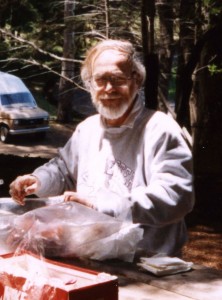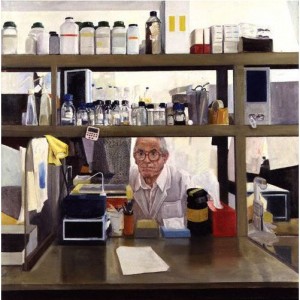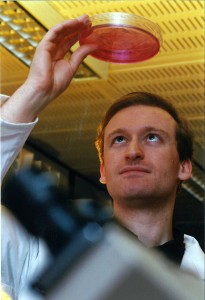What’s it like to make a discovery? Viewed from the outside, the path to scientific glory is as follows: scientists, serious, white-coated individuals in safety glasses, work long hours in the lab meticulously replicating their experiments until a conclusion is reached; at some point this involves holding a tube or petri dish and looking intently at the contents and/or staring at something complicated on a computer;
then, the results are written up, submitted to a journal, and get published. If they’re exciting enough, somebody tells the newspapers, and the world finds out. Well, it’s a bit like that, but only in the same way that a toddler’s drawing resembles the original. Here’s what really happens:
1. Somebody asks a question. Sometimes it’s entirely novel, reached by a long process based on logical deduction and formulation of hypotheses, or sometimes it’s so totally obvious that everyone is surprised that nobody seems to have thought of asking it before (sometimes, someone has asked it before, but in a different context; nicking ideas like this is called Doing Crossover Research, and is much lauded). Usually, it’s somewhere in between these two extremes.
2a. Is there a way of answering the question? If not, it sits in lonely splendour at the top of a “to-do” list for anything between days and years, waiting for the field to advance technologically and intellectually until there is a way of approaching it.
2b. Is there almost a way of answering the question? If so, someone with whizzo technical skills will be lumbered with figuring out how to adapt equipment and methodology to suit. Fixing this can take a really long time.
2c. If there are existing methods that work, experiments can begin. NB if the method in question is new, for a short time, a few places in the world that have the kit and know-how will have an edge; recognising and exploiting this to do really important stuff is a crucial skill in climbing the greasy pole to scientific success.
3. Have you got enough money to pay for the research? If you have hit the jackpot and work in an institute with core funding (like the ICRF/LRI), then you probably do. What’s even better, you’ll be able to try out some risky experimental strategies before the people with the purse strings notice and try to get you to do something safer. If you rely on applying for grants, you may struggle to get money if you don’t have a good track record, if your idea is too off the wall, or if you simply don’t make the cut for funding even if the grants committee approves your proposal. At this point, you can try writing a grant for something a bit safer, hope it gets funded, and drizzle some of the grant into your Big Unfundable Idea on the quiet.
4. Who’s going to do the work? If you’re talented at the bench and young, you can do it by yourself or with minimal assistance – a research assistant, or a PhD student perhaps. This is probably the most satisfying way to do experiments; the point in their careers when such single-minded creativity is possible is the
time that most scientists remember with great fondness. If you’re running a lab, and have any outside interests such as a family or a personal life, you won’t have time to do the work by yourself, what with grants and papers to write, babies or boyfriends to nurture, committees to sit on and endless paperwork to do (not to mention rewriting your last mediocre student’s PhD thesis). In any case you’ve probably retired from the bench into an office, and you’re just going to have to delegate. Do you have a talented postdoc (I mean a really talented postdoc, not just the seminarspeak sort) or a genius graduate student, or a brilliant technician? If so, you’re in clover; buy them lots of chocolate or whatever their lab stimulant of choice is, be extremely nice and attentive to them, and watch your dreams come true. If not, prepare to get very frustrated. There’s nothing worse than watching somebody else cocking up an experiment you know you could do with your eyes shut if you just had the time. Under no circumstances try shouting and throwing things; labs do not thrive when the lab head resembles the place on the horse where the sun doesn’t shine. Breathe deeply, and be gentle with your colleagues. With luck, you’ll get there anyway, and they in turn will be vastly improved scientists.
5. Now you’ve got your data, are they correct? An alarmingly large proportion of published papers are wrong (somewhere between 14% and 75% depending on who you believe), not because of fraud, but because exceptional new results are more likely to be exceptional deviations from what’s actually true, but everyone wants to believe them anyway. Check, double check, do the statistics (properly, not just using an excel spreadsheet function you don’t really understand; you’re just going to have to find a good statistician). Never ignore anything, never discard the dirty data that don’t match the one beautiful clean result that supports your hypothesis. Negative results matter just as much as positive ones.
6. Don’t get scooped. Don’t tell your results to anyone you don’t know and trust, and if possible, bind them to secrecy. In the old days, results were shared prior to publication by speaking about them at conferences, mailing them around the world as preprints of manuscripts in preparation, and talking to colleagues. The community was small enough that pinching someone else’s data and passing it off as your own was quite hard to do, although not unknown. Unfortunately, a culture grew up whereby, upon hearing about your data, another lab that was almost there but not quite would ramp up their activities and try to rush a paper out in a competing journal. Gradually, enough people got burned by this practice that nowadays, conferences have become vehicles for discussing published or soon-to-be published work; they exist in the recent past (or in some cases, the historic past), rather than the present. So, keep very quiet, and write up very fast, ensuring, of course, that condition (5) applies. If you’ve detected that rushing into print and being quite sure of the veracity of your data are sometimes mutually exclusive, you’re correct.
7. If you’ve done the work yourself, writing a paper is relatively simple, assuming someone has at some point taught you how to write clearly and concisely. Write down what you did, have some trusted colleagues critique your paper, and send it to a journal. If your lab is involved, things get more complicated. Your desire to educate your lab members in the correct writing of papers may turn out to be in direct opposition to your desire to produce a compittentllie spellt and well-argued manuscript in less than a decade. Persevere, but be aware that it’s going to hurt. Possibly a lot.
8. Select a journal. How brave are you? Are you going to eschew Cell, Nature and Science, the “luxury” journals to which Randy Schekman, 2013 Nobel Laureate in Physiology and Medicine is so opposed? Many people complain that the scientific judgment of the top-dog publications is severely compromised by their desire to publish high profile papers, and that like all manufacturers of luxury goods, they have conned the scientific community into believing that exclusivity is the same as importance. However, many of these same people still publish there if they possibly can, as papers in top journals equate to jobs, status, and grants. There’s a need for a revolution in science publishing, but that’s a topic for another day.
9. Send your paper off. If you’ve gone for Cell, Nature or Science, prepare to receive it back almost as soon as you’ve finished wrestling with their devilish online submission software, guaranteed to transform even the most steadfast soul into a sobbing piece of human wreckage. Argue with them (politely), and if they continue to say no, send it somewhere else. Repeat software wrestling process, perhaps after copious doses of your favourite beverage choice. If paper pings back faster than a speeding bullet once more, keep going until a journal with proper editors realises that your magnum opus is worth sending out for peer review.

Mike Bishop, 1989. Just once in my career, I published in Cell without revision. The identity of the co-author may have helped a bit.
10. Receive reviews. Do not open any email which may contain reviewers’ comments in front of young, impressionable lab members, particularly if it is their first attempt into print; you may cause untold lasting damage to their psyches. Appropriate reactions to reviews are outlined below:
- If the reviewers all love your paper and have recommended publication with no revision, you are in fact asleep. Enjoy your dream while you can; it is unlikely to be matched in reality.
- The reviewers like your paper and although they have suggested a few simple changes and perhaps some straightforward extra experiments, they want to see it published. Pinch yourself, because you may still be in the Land of Nod. If actually awake, celebrate wildly.
- The reviewers quite like your paper and have suggested some pretty hard extra experiments that may take a long time. It’s still a yes though, so worth some moderate celebration, coupled with indignant shouting about how obtuse they’ve been: can’t the blasted journal editor see the experiments the reviewers have recommended are a waste of time?
- Nope, they don’t like it at all. The comments range from personal attacks calling into question the authors’ probity and intelligence, to polite but merciless intellectual disembowelling. Get very cross. When you’ve calmed down, read the comments again and see if they’ve got a point. Regroup, rewrite if necessary, do some more experiments if necessary, and return to stage 9. Repeat stages 9 and 10 ad not-quite infinitum but probably nauseam.
11. This is the best bit. You’ve got your paper into a decent journal that people actually read. You can talk about your work to all and sundry, and if you’re on the conference circuit, you have a new story to tell. You feel fantastic! Your lab is flying high, you’re getting invitations to give seminars in fancy places, and perhaps you’ve just done a tv interview that your Mum is going to love. Dreams of future career greatness preoccupy your waking thoughts.

Did not have a problem thinking of the next big question: Fred Sanger, © National Portrait Gallery, London
But…
12. Now you’ve got to do it all over again or you won’t get any more grants, applicants for places in your lab, pay rises, kudos, tv time…. Aargh!!!
And so…
Back to step 1 again. Go on, you know you enjoy it really.




Discussion
No comments yet.